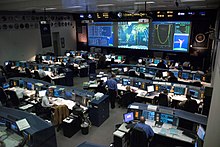Overview of Control Rooms
– Control rooms serve as a central space for monitoring and controlling large facilities or services.
– They became common in factories during the 1920s.
– Control rooms for vital facilities are tightly secured and inaccessible to the public.
– Multiple electronic displays and control panels are present.
– Some control rooms are under video surveillance for security purposes.
Examples of Control Rooms
– Nuclear power plants and power-generating stations.
– Oil refineries and chemical plants.
– Airlines, also known as operations control centers.
– Major transportation facilities such as bridges, tunnels, and rapid transit systems.
– Military facilities, including missile silos and NORAD.
Special Hazards and Mitigation in Control Rooms
– Control rooms have fire suppression and security systems.
– They can serve as areas of refuge in hazardous environments.
– Special electrical power supply and air conditioning are needed due to the concentration of equipment.
– Penetrations for cables require vigilant firestop management.
– Positive pressure ventilation is used to prevent smoke or toxic gases from entering.
Design Considerations for Control Rooms
– Control room design incorporates ergonomic and aesthetic features.
– Considerations include traffic flow, acoustics, illumination, and worker safety.
– Placement of humans and equipment is optimized for easy movement and interaction.
– Noise and distractions are minimized.
– Design ensures readiness for emergency situations.
Control Rooms in Popular Culture
– Control room scenes appear frequently in thriller novels and action films.
– Documentaries have been filmed in real-life control room settings.
– Examples include the films ‘Fail-Safe,’ ‘The Prisoner,’ and ‘The Taking of Pelham One Two Three.’
– ‘The China Syndrome’ and ‘GoldenEye’ also feature control rooms.
– The documentary film ‘Control Room’ focuses on Al Jazeera and its coverage of the 2003 invasion of Iraq.
Operational Needs and Disruptions in Control Room Operations
– JetBlue anticipates operational needs.
– The airline stays ahead of potential disruptions.
– Fleet expansion continues.
– MRO network helps manage system operations.
– Operational planning is crucial for JetBlue’s success.
Control Room Operations
– The control room is a central hub for managing operations.
– It monitors flights and tracks aircraft movements.
– Control room operators make critical decisions in real-time.
– Communication with pilots and ground staff is essential.
– The control room ensures smooth operations and safety.
Fleet Expansion
– JetBlue is expanding its fleet.
– More aircraft means more operational challenges.
– The MRO network helps manage the growing fleet.
– Operational planning is key during fleet expansion.
– JetBlue aims to maintain high operational efficiency.
Anticipating Disruptions
– JetBlue proactively identifies potential disruptions.
– Weather conditions and air traffic are monitored closely.
– Contingency plans are in place to mitigate disruptions.
– Communication with passengers is crucial during disruptions.
– JetBlue aims to minimize the impact of disruptions.
Operational Success
– Efficient system operations contribute to JetBlue’s success.
– The MRO network plays a crucial role in achieving operational goals.
– Operational planning and control room operations are key factors.
– JetBlue focuses on maintaining high operational standards.
– Continuous improvement is a priority for JetBlue’s operations. Source: https://en.wikipedia.org/wiki/Control_room
This article needs additional citations for verification. (September 2010) |
A control room or operations room is a central space where a large physical facility or physically dispersed service can be monitored and controlled. It is often part of a larger command center.


